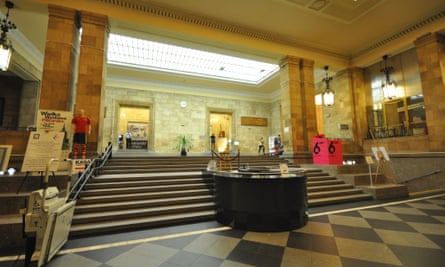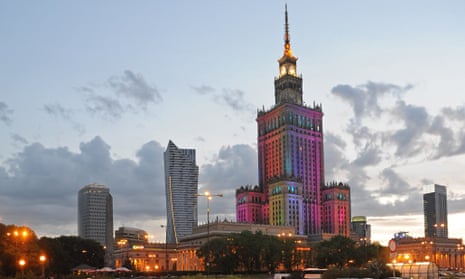There has been no more pivotal a building constructed in Poland after 1945 than the Palace of Culture and Science – or to give it its full title: “the Palace of Culture and Science in the name of Joseph Stalin”. And none more divisive and controversial, either.
It’s a skyscraper 231 metres tall, the highest building in Poland, built in a mixture of then-compulsory Socialist realism with elements of Polish historicism. It stands for everything Poland tried to reject after the fall of the Berlin Wall in 1989 and the swift crumbling of the Soviet Union, and better than any other building it epitomises the 44 years of the People’s Polish Republic.
The palace turns 60 this year: it was finished 10 years after the end of the second world war, which both destroyed and transformed Poland. What came after was the greatest challenge in the country’s history – to this day, people can’t decide whether it was a failure, or a success.
Started in 1952, the Palace was a cornerstone of the Warsaw to come, planned together with a majestic Parade Square. During construction it was still surrounded by post-war ruins, with people living in tenements cut in half by bomb craters, survivors of Warsaw’s razing by the Nazis in 1944.

The Palace’s chief architect, Lev Rudnev, collaborated with a Polish team of architects, but – as a “gift” from Stalin – it was built by 3,500 Soviet workmen, who were housed in a special estate during the time of construction. It may have been Stalinist folly to build such an opulent palace while the rest of the city barely existed; but one can also imagine this new building bringing hope and inspiration to a city being transformed, not just physically but socially. Thousands of people poured in from across the devastated country to help rebuild the capital.
Rudnev’s plan for the tower was influenced by his previous work on the most impressive of the Moscow skyscrapers, the Moscow State University, which served as his blueprint. In Warsaw, Rudnev’s grand idea for the palace was an eclectic mix of Russian baroque and gothic details on a steel-framed tower.
To call Socialist realism eclectic is, of course, heresy – officially it was to be “socialist in content, national in form”. But there’s no such thing as purely “national” architecture, and in practice the palace was incredibly eclectic: for research, Rudnev travelled to key Polish heritage sites in Kraków and Zamość to study Polish renaissance architecture, resulting in the spiky “Polish parapets” that decorate the roof of the building.
The palace’s exterior was also extremely elaborate: it is surrounded by dozens of monumental sculptures in the classical style of Michelangelo’s ignudi, including astronomer and mathematician Copernicus, Romantic poet Adam Mickiewicz, pioneering physicist Marie Curie, as well as idealised model workers – the most famous one holding a Ten Commandments-style book inscribed with the names of Marx, Engels and Lenin (Stalin’s name was carefully removed after 1956).
But if you think the exterior is something – well, come inside. The palace shocks equally from the interior, with marble floors and endless staircases and corridors that dazzle with their weighty glass chandeliers and gilded finishings. Like the famous Moscow metro system, this was luxury for the masses.
But what differentiated the palace from its Muscovite cousins was its entirely public use – it was designed to hold several museums, theatres and sports venues. The same congress room with seating for 3,000 guests that for years held the Communist Party’s annual meetings, also hosted legendary gigs by the Rolling Stones and Leonard Cohen.

The palace was a symbol of how strategically important Poland was to Moscow – and to Stalin. It could even have been built as a veiled apology, however bizarre, for the initial Soviet-backed burden of terror experienced during the installation of the communist system: the rigged elections, detentions and even executions, especially of members of the Home Army. But this past was seldom spoken about until the 1970s and the anti-communist (yet socialist in spirit) people’s Solidarity movement.
In many ways, Poland’s experience of communism could have been much worse. The mid-1950s, when the palace was built, were the nearest thing to prosperity most people in the Socialist republics ever experienced. Poland was a part of the Soviet Bloc but not the Soviet Union, enjoying more freedoms than many other countries behind the Iron Curtain. Particularly after the political “thaw” in 1956, it had the region’s most interesting and relatively free press, avant-garde cinema, art, literature and music, and all this thanks to state support.
Today, the palace is home to concerts, wonderfully quirky museums, the city’s most popular multiplex cinema, and several hip bars and theatres. It also hosts the biggest Polish casino, a sign of the times.
Both loved and hated passionately, the palace stands as a symbol of Warsaw’s destruction, its resurrection at the hands of an unpopular, Soviet-imposed government – and, in recent years, as a reminder of Poland’s past that paralyses it today, as public discussion about the country’s shared history is hijacked by ritual wars between nationalist Catholics and liberals.
Perhaps this is why some think that demolishing the palace would destroy any memory of communism, with Poland’s image emerging cleaner and more innocent as a result. But memories don’t work like that. Despite occasional threats of demolition – or privatisation – it is simply too big, too statuesque and too symbolic to get rid of in any organised manner. Surrounded by tacky skyscrapers built after 1989 (symbols of hasty money-making), the palace has resisted significant changes in Poland’s political system, and will continue to do so.
- Which other buildings in the world tell stories about urban history? Share your own pictures and descriptions with GuardianWitness, on Twitter and Instagram using #hoc50 or let us know suggestions in the comments below

Comments (…)
Sign in or create your Guardian account to join the discussion